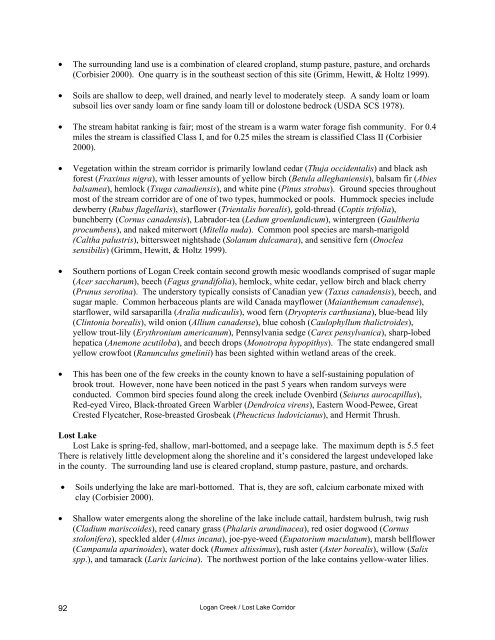Guide to Significant Wildlife Habitat - Door County Web Map
Guide to Significant Wildlife Habitat - Door County Web Map
Guide to Significant Wildlife Habitat - Door County Web Map
You also want an ePaper? Increase the reach of your titles
YUMPU automatically turns print PDFs into web optimized ePapers that Google loves.
• The surrounding land use is a combination of cleared cropland, stump pasture, pasture, and orchards<br />
(Corbisier 2000). One quarry is in the southeast section of this site (Grimm, Hewitt, & Holtz 1999).<br />
• Soils are shallow <strong>to</strong> deep, well drained, and nearly level <strong>to</strong> moderately steep. A sandy loam or loam<br />
subsoil lies over sandy loam or fine sandy loam till or dolos<strong>to</strong>ne bedrock (USDA SCS 1978).<br />
• The stream habitat ranking is fair; most of the stream is a warm water forage fish community. For 0.4<br />
miles the stream is classified Class I, and for 0.25 miles the stream is classified Class II (Corbisier<br />
2000).<br />
• Vegetation within the stream corridor is primarily lowland cedar (Thuja occidentalis) and black ash<br />
forest (Fraxinus nigra), with lesser amounts of yellow birch (Betula alleghaniensis), balsam fir (Abies<br />
balsamea), hemlock (Tsuga canadiensis), and white pine (Pinus strobus). Ground species throughout<br />
most of the stream corridor are of one of two types, hummocked or pools. Hummock species include<br />
dewberry (Rubus flagellaris), starflower (Trientalis borealis), gold-thread (Coptis trifolia),<br />
bunchberry (Cornus canadensis), Labrador-tea (Ledum groenlandicum), wintergreen (Gaultheria<br />
procumbens), and naked miterwort (Mitella nuda). Common pool species are marsh-marigold<br />
(Caltha palustris), bittersweet nightshade (Solanum dulcamara), and sensitive fern (Onoclea<br />
sensibilis) (Grimm, Hewitt, & Holtz 1999).<br />
• Southern portions of Logan Creek contain second growth mesic woodlands comprised of sugar maple<br />
(Acer saccharum), beech (Fagus grandifolia), hemlock, white cedar, yellow birch and black cherry<br />
(Prunus serotina). The unders<strong>to</strong>ry typically consists of Canadian yew (Taxus canadensis), beech, and<br />
sugar maple. Common herbaceous plants are wild Canada mayflower (Maianthemum canadense),<br />
starflower, wild sarsaparilla (Aralia nudicaulis), wood fern (Dryopteris carthusiana), blue-bead lily<br />
(Clin<strong>to</strong>nia borealis), wild onion (Allium canadense), blue cohosh (Caulophyllum thalictroides),<br />
yellow trout-lily (Erythronium americanum), Pennsylvania sedge (Carex pensylvanica), sharp-lobed<br />
hepatica (Anemone acutiloba), and beech drops (Monotropa hypopithys). The state endangered small<br />
yellow crowfoot (Ranunculus gmelinii) has been sighted within wetland areas of the creek.<br />
• This has been one of the few creeks in the county known <strong>to</strong> have a self-sustaining population of<br />
brook trout. However, none have been noticed in the past 5 years when random surveys were<br />
conducted. Common bird species found along the creek include Ovenbird (Seiurus aurocapillus),<br />
Red-eyed Vireo, Black-throated Green Warbler (Dendroica virens), Eastern Wood-Pewee, Great<br />
Crested Flycatcher, Rose-breasted Grosbeak (Pheucticus ludovicianus), and Hermit Thrush.<br />
Lost Lake<br />
Lost Lake is spring-fed, shallow, marl-bot<strong>to</strong>med, and a seepage lake. The maximum depth is 5.5 feet<br />
There is relatively little development along the shoreline and it’s considered the largest undeveloped lake<br />
in the county. The surrounding land use is cleared cropland, stump pasture, pasture, and orchards.<br />
• Soils underlying the lake are marl-bot<strong>to</strong>med. That is, they are soft, calcium carbonate mixed with<br />
clay (Corbisier 2000).<br />
• Shallow water emergents along the shoreline of the lake include cattail, hardstem bulrush, twig rush<br />
(Cladium mariscoides), reed canary grass (Phalaris arundinacea), red osier dogwood (Cornus<br />
s<strong>to</strong>lonifera), speckled alder (Alnus incana), joe-pye-weed (Eupa<strong>to</strong>rium maculatum), marsh bellflower<br />
(Campanula aparinoides), water dock (Rumex altissimus), rush aster (Aster borealis), willow (Salix<br />
spp.), and tamarack (Larix laricina). The northwest portion of the lake contains yellow-water lilies.<br />
92<br />
Logan Creek / Lost Lake Corridor




![A Guide to the Control and Management of Invasive Phragmites [PDF]](https://img.yumpu.com/19126786/1/190x190/a-guide-to-the-control-and-management-of-invasive-phragmites-pdf.jpg?quality=85)







![Homeowner's Guide to Japanese Knotweed Control [PDF]](https://img.yumpu.com/19126766/1/190x245/homeowners-guide-to-japanese-knotweed-control-pdf.jpg?quality=85)




